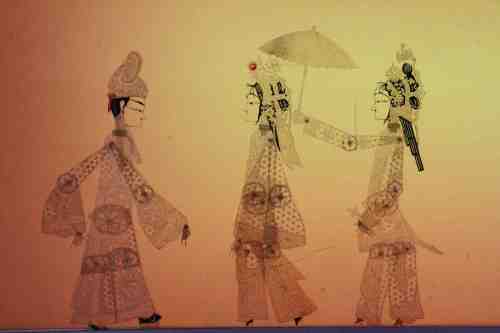 A young scholar approaches two young ladies.
A young scholar approaches two young ladies.
The silence on this blog for the last few months has not been for lack of content, on the contrary! I’ve just begun my long road to a PhD and my focus, of course, is Chinese shadow puppetry. Luckily, so far it has been nothing short of wonderful. As one of my friends put it, “I think you’re the only person enjoying their first PhD semester in the entire world.”
My enjoyment is partially because the program I’m studying in is a flexible, practice-based interdisciplinary PhD, which is perfect for a self-guided student such as me. I know what I need and they’re giving me the support to do just that. Mostly, though, it’s because I love what I’m doing. Spending days curled up on the couch, reading deeply about the form I care about so much is nothing short of a privilege.
In the last few months, I’ve finally had the chance to read through the written texts I’ve collected over the years about Chinese shadow puppetry and even find a few more. I’ve spent time in rare books collections, made indulgent use of the inter-library loan system and absolutely exploited my newfound access to online journal databases. It’s not easy to hunt this stuff down, almost as hard as tracking down a troupe in the countryside of China.
What’s struck me in the canon of texts is just how different the understanding of the form is depending on who’s writing about it. This is true for anything – our position in the world so limiting our purview on everything we see – but strikingly true here. In some ways, this was frustrating at first. How was I supposed to make sense of it? And in other ways this is exactly what is has to be and always will be. A live performance art form is evolving in every iteration, every performance. Multiply this by region, generation and circumstance and you do have a pluralistic performance art form that can be almost anything you choose to describe it as.
Whatever I end up writing or creating to communicate my understanding of shadow puppetry will fall into this category sooner or later: there is no way to capture its full essence, existence or possibility in any form. Thank goodness, or I’d be gearing up for a pretty boring five years.
Thanks for reading~
BIBLIOGRAPHY
A short compiled Bibliography for anyone who is interested!
This list is certainly not exhaustive, but fairly complete of the easier to find texts in English. Some are journal articles and some are books. Most can be obtained from Jstor’s Online Journal Database, the inter-library loan system and your local library.
Chang, Lily. The lost roots of Chinese shadow theater: a comparison with the actors’ theater of China. Los Angeles, CA: Lecture at University of Southern California, 1982. Print.
Chen, Fan. Visions for the masses: Chinese shadow plays from Shaanxi and Shanxi. Ithaca, N.Y.: East Asia Program, Cornell University, 2004. Print.
Chen, Fan. Chinese shadow theatre history, popular religion, and women warriors. Montreal [Que.: McGill-Queen’s University Press, 2007. Print.
Chen, Fan Pen Li, and Bradford Clark. “A Survey of Puppetry in China (Summers 2008-2009).” Asian Theatre Journal 27.2 (2010): 333-365. Print.
Cohen, Alvin. “Documentation Relating to the Origins of the Chinese Shadow Puppet Theater .” Asia Major 13.1 (2000): 83-108. Print.
Kronthal, Lisa. “Conservation of Chinese Shadow Figures: Investigations into their Manufacture, Storage, and Treatment.” Journal of the American Institute for Conservation 40.1 (2001): 1-14. Print.
Laufer, Berthold. Oriental theatricals. Chicago: [Field Museum of Natural History, Chicago], 1923. Print.
Liu, Jilin. Chinese shadow puppet plays. Beijing: Morning Glory Publishers, 1988. Print.
March, Benjamin, and Paul McPharlin. Chinese shadow figure plays and their making,. Detroit: Inland Press, 1938. Print.
Menzies, Grant. Shadow woman: the extraordinary career of Pauline Benton. Montreal: McGill-Queen’s University Press, 2013. Print.
Pimpaneau, Jacques. Shadow figures of Asia from the collection of Pauline Benton. Saint Paul, Minn.: Minnesota Museum of Art, 1970. Print.
Swiderski, Richard M. . “The Aesthetics of a Contemporary Chinese Shadow Theatre.” Asian Folklore Studies 43.2 (1984): 261-273. Print.
Wimsatt, Genevieve. Chinese shadow shows,. Cambridge, Mass.: Harvard University Press, 1936. Print.

Great to read your blog entry. Glad you are going to try and keep up and let us in on what is happening in your PHD research! Is that the plan?
I wasn’t quite sure what you meant at the last paragraph…when you referred to “this category”….?? and then when you said the thing about boiled down into a form…. I mean, I think I get it, but it could be clearer.
Happy Thanksgiving. We have much to be grateful for. You’ll be home soon, too. Love, Mom
Date: Wed, 27 Nov 2013 21:36:33 +0000 To: zgreenwood2@hotmail.com